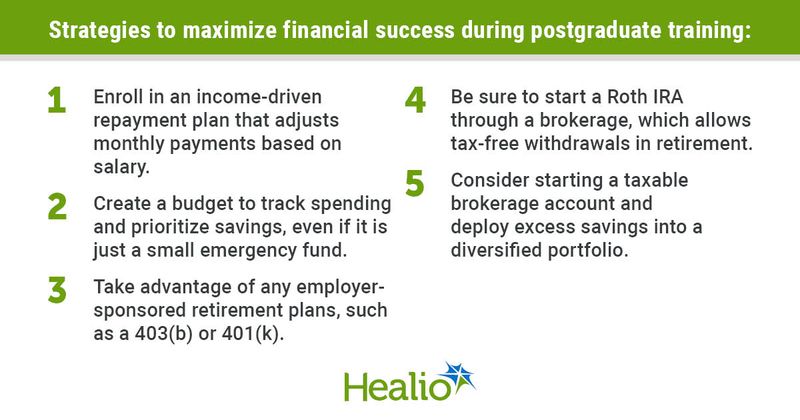Financial planning for physicians: Key milestones to meet at every career stage
Key takeaways:
- Financial planning is a lifelong process that evolves with one’s career and stage of life.
- It is critical for physicians to avoid excessive lifestyle upgrades at the expense of saving and debt service.
As a physician, your career will be rewarding in many ways, including a personal sense of purpose, ability to help others and the potential for high-earning power.
However, the career also comes with unique financial challenges, such as prolonged education and training, high student loan debt and elevated malpractice and disability insurance premiums. Strategic financial planning throughout one’s career is essential to ensure a comfortable lifestyle while also managing debts and retiring on one’s own terms. In this article, we explore the key financial milestones at each stage of a physician’s career, providing a roadmap for long-term financial security.

Residency: Building the foundation


Physicians can spend up to 7 years in postgraduate training, where salaries are modest compared with the income potential later in life. Despite the lower income, financial decisions made during residency can significantly affect one’s future. Below are some strategies to maximize success.
Debt management: One of the most pressing financial concerns for residents and fellows is managing ever-burgeoning medical school debt. One powerful strategy involves enrolling in an income-driven repayment plan that adjusts monthly payments based on salary. If you work in a nonprofit academic medical center during residency and fellowship, you may stand to benefit from the Public Service Loan Forgiveness program if you continue this practice for the first few years of your career after training.
Budgeting: Even with a lower income, it is essential to cultivate sound financial habits. Create a budget to track spending and prioritize savings, even if it is just a small emergency fund. Getting into the habit of saving, and making modest investments, will serve you well later in your career.
Retirement and early life planning: Although it may feel premature, actively contributing toward retirement and early life goals during residency is important. Take advantage of any employer-sponsored retirement plans, such as a 403(b) or 401(k). Also, be sure to start a Roth IRA through a brokerage, which allows tax-free withdrawals in retirement. Finally, consider starting a taxable brokerage account and deploy excess savings into a diversified portfolio to take advantage of the power of compounding.
Increase income, save aggressively
Once training has been completed, physicians will see a dramatic increase in earning potential. It is critical to avoid the temptation of excessively upgrading a lifestyle at the expense of saving and debt service. It is crucial to prioritize long-term financial goals instead of short-term gratification.
Emergency fund and debt payoff: With your first attending job, prioritize building a robust emergency fund that covers 6 months of living expenses. Also, consider aggressively paying off high-interest debt, particularly student and credit card debt. Refinancing loans to a lower interest rate might make sense now that you have a higher income but be sure to consider ramifications to the Public Service Loan Forgiveness program if you plan on participating.
Retirement contributions: Maximize contributions to employer-sponsored retirement accounts, such as a 401(k) or 403(b). Take advantage of employer matching programs and contribute maximum amounts to a traditional or Roth IRA using the backdoor mechanism. Also be sure to contribute excess savings to a taxable brokerage account with safe, conservative investment habits in index funds or a diversified portfolio.
Disability insurance: As a physician, one’s income is tied to the ability to work. Securing a comprehensive own-occupation disability insurance policy is critical to safeguarding one’s financial future in case of injury or illness.
Lifestyle creep: While it is tempting to upgrade a lifestyle as income increases, be mindful of lifestyle creep — ie, spending more as one makes more. Avoid overcommitting to large, fixed expenses, such as high mortgages or car payments that could hinder financial flexibility.
Peak earnings, long-term investments
By mid-career, most physicians are in their 40s or early 50s and at the peak of their earning potential. While income is high, so too are financial obligations, which typically include mortgages, tuition payments and funding for long-term goals.
Investment strategy: By this stage, a portfolio hopefully is well-diversified and includes a mix of stocks, bonds and alternative investments, like private investments, real estate or cryptocurrency. Consider working with a financial advisor to fine-tune one’s investment strategy based on risk tolerance and retirement goals.
Tax-efficient strategies: With a higher income, taxes become a major consideration that affects wealth creation. Explore tax-saving opportunities, such as contributing to a health savings account, which offers triple tax benefits, and engaging in tax-loss harvesting to offset capital gains.
College savings plans: If you have children, now is the time to fully fund their educational savings plans, such as 529 plans or Coverdell Educational Savings Accounts. These accounts grow tax free and can be used for qualified educational expenses.
Estate planning: Work with an attorney to establish a will, a trust and other legal documents to ensure that assets are distributed according to one’s wishes.
Protect assets
As physicians approach retirement, the focus shifts from accumulation to protection and distribution of one’s assets. Proper planning during this stage ensures that you can maintain your lifestyle throughout your retirement without running out of money.
Retirement income planning: Start developing a plan for drawing down retirement savings in the most tax-efficient manner. Consider working with a financial advisor to come up with a plan to utilize tax-deferred, taxable and tax-free accounts to its maximum potential to optimize withdrawals.
Long-term care insurance: Purchase long-term care insurance to protect against the high costs of assisted living or nursing care in your later years. The earlier one purchases a policy, the more affordable it will be.
Health care in retirement: Plan for the cost of health care, including Medicare premiums, supplemental insurance and out-of-pocket costs. Health care expenses can quickly erode retirement savings without adequate preparation.
Lifetime of financial planning
Financial planning is a lifelong process that evolves with one’s career and stage of life. Whether you are just starting residency or approaching retirement, taking proactive steps at each stage will ensure long-term financial security and allow you to enjoy the fruits of your labor in retirement.
Physicians have unique earning potential but also career challenges that should be carefully planned for. By following this roadmap and working with trusted financial professionals, you can navigate your career with confidence and retire on your terms.
Reference:
Mandell and OJM Group partners are pleased to announce the 2024 publication of our newest book, Wealth Strategies for Today’s Physician: A Multi-Media Playbook. The playbook’s innovative format features more than 90 links to videos and podcast episodes to enhance important financial topics for physicians. To receive a free print copy or ebook download, text HEALIO to 844-418-1212, or visit www.ojmbookstore.com and enter code HEALIO at checkout.
For more information:
Sanjeev Bhatia, MD, is an orthopedic sports medicine surgeon practicing at Northwestern Medicine in Warrenville, IL. He can be reached at sanjeevbhatia1@gmail.com or @DrBhatiaOrtho.
David B. Mandell, JD, MBA, is an attorney and founder of the wealth management firm OJM Group www.ojmgroup.com. He can be reached at 877-656-4362 or mandell@ojmgroup.com.

